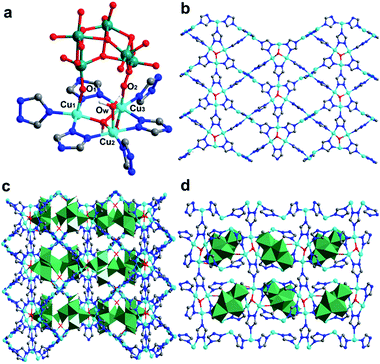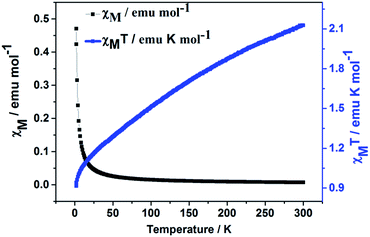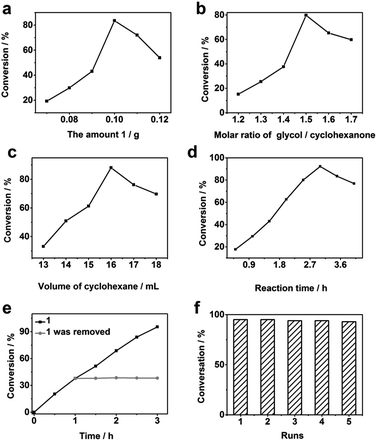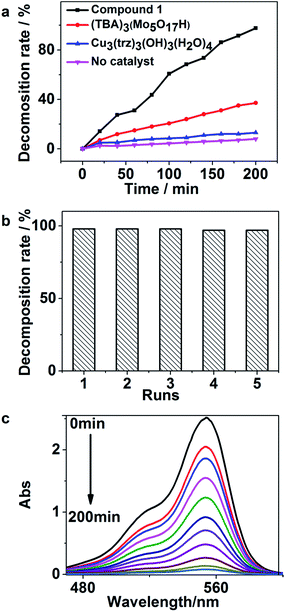 Open Access Article
Open Access ArticleSynthesis and properties of a POM-based trinuclear copper(II) triazole framework†
Li Xu,
Ying Lu *,
Liping Huang,
Xiaohui Li,
Shuang Wang,
Zhong Zhang and
Shuxia Liu
*,
Liping Huang,
Xiaohui Li,
Shuang Wang,
Zhong Zhang and
Shuxia Liu *
*
Key Laboratory of Polyoxometalate Science of the Ministry of Education, College of Chemistry, Northeast Normal University, Changchun, Jilin 130024, China. E-mail: liusx@nenu.edu.cn; Fax: +86-431-85099328
First published on 9th January 2018
Abstract
A novel POM-based trinuclear copper(II) triazole framework, namely, [H2{Cu6(trz)6(μ3-OH)2}Mo5O18]·3H2O (1) was isolated using a hydrothermal method, which displays a 3D network constructed from trinuclear copper(II) units and triazole ligands with [Mo5O18]6− anions as templates. 1 has been identified by single crystal X-ray diffraction, elemental analysis, thermogravimetric analysis, powder X-ray diffraction and FT-IR. Magnetic studies indicate that antiferromagnetic interactions exist in 1. In addition, 1 exhibits good Lewis acid catalytic activity for the synthesis of cyclohexanone ethylene ketal with 95% conversion. The HOMO–LUMO gap (Eg) of 1 is 2.34 eV calculated using the Kubelka–Munk equation (Fhν)0.5, indicating that its forbidden bandwidth belongs to the semiconductor category. Visible-light photodegradation of RhB catalyzed by 1 was investigated, which shows high activity with an above 98% degradation rate.
Introduction
Polyoxometalates (POMs), as a class of nanosized metal-oxo clusters composed of group VI (Mo and W) and group V (V, Nb and Ta) elements in their highest oxidation state, have received increasing attention owing to their aesthetically appealing structures and wide applications such as in the fields of magnetism,1 and catalysis.2 Due to their strong acidity and fast multielectron transformation activity, POMs can be employed as acid, redox and bifunctional (acid and redox) catalysts in many synthetically useful organic reactions. Moreover, they can act as excellent photocatalysts in the oxidation of organic compounds owing to their ability as electron and oxygen relays.3 Trinuclear triangular copper(II) (TTC) clusters with the formula {Cu3(μ3-OH)(L)3} (L = pyrazole, imidozole, triazole, terazole and the derivatives of them) possess a planar structure composed of three copper centers held together by a central μ3-O atom.4 In the TTC cluster, each Cu(II) center is coordinatively unsaturated with open coordination sites, which is a potential active site in Lewis acid and oxidation catalytic reactions.5 Designing MOFs based on TTC units have attracted great attention of researchers owing to their promising applications in catalysis.5 For examples, Zhang et al.6a synthesized a active-site-accessible porous MOF using TTC as SBU, which shows high activity for the CO catalytic oxidation, giving a conversion rate of 100%. Mondal et al.6b reported a series of MOFs based on TTC units, which show high activity in the photocatalytic degradation of toxic dye molecules. Furthermore, due to their interesting magnetic properties, TCC clusters have attracted attention in the construction of magnetic high-nuclear clusters and MOFs materials. For an example, Ouellette et al. reported a microporous metal–organic framework constructed with magnetic {Cu3(μ3-OH)(trz)3}2+ building blocks.7Inspired by the properties of POMs and TTC clusters, we explored to encapsulate POMs into the host matrix of MOFs built by TTC units. Firstly, due to the promising catalytic performances of both POMs and TTC units, the obtained POMs-based TTC frameworks may show enhanced catalytic activity by the combination and synergies of the functions of POMs and TTC units. Secondly, the inlay of POMs into the host matrix of MOFs built by TTC units would effectively enhance the stability of both POMs and TTC frameworks, which is an essential prerequisite for practical applications.8 Finally, the combination of magnetic TCC units and POMs, interesting magnetic properties may be evoked. Although some POM-based MOFs have been synthesized, to our knowledge, the POM-based MOFs combined POM and TCC units have never been reported. Herein, a POM-based trinuclear–copper(II) triazole framework, [{H2Cu6(trz)6(μ3-OH)2}Mo5O18]·3H2O (1) (trz = 1,2,4-triazole), has been successfully synthesized under hydrothermal condition. The catalytic performance of 1 was assessed by choosing the synthesis of cyclohexanone ethylene ketal catalyzed by Lewis acid and visible-light photodegradation of RhB as testing reactions. In addition, the magnetic property of 1 has been investigated.
Experimental
Materials and methods
(TBA)2[Mo6O19] (TBA = tetrabutylammonium) was prepared according to the literature procedures.9 Other chemicals were obtained commercially and used without further purification. Crystal morphology was characterized by using a Quanta 250 FEG scanning electron microscope. Fourier transform infrared spectroscopies (FT-IR) were recorded in the range 400–4000 cm−1 on an Alpha Centaurt FT-IR spectrophotometer using KBr pellets. Single crystal XRD analysis of 1 were conducted on a Bruker Smart Apex CCD diffractometer with Mo Kα monochromated radiation (λ = 0.71073 Å) at room temperature. Powder X-ray diffraction (PXRD) measurements were performed on a Rigaku D/MAX-3 instrument with Cu Kα (λ = 1.5418 Å) radiation in the angular range 2θ 3–50° at 293 K. Thermogravimetric analysis (TGA) was performed on a Perkin-Elmer TGA7 instrument, with a heating rate of 10 °C min−1 under a nitrogen atmosphere. The magnetic susceptibility data were obtained on a SQUID magnetometer (Quantum Design, MPMS-5) in the temperature range 2–300 K with applied field of 1000 Oe. GC analyses were performed on an Agilent 6820 instrument with a flame ionization detector.Procedure for catalytic condensation of cyclohexanone and glycol
The ketalization reaction was performed in a three-necked round-bottomed flask with a given mass of 1. Then, reasonable volume ratio of cyclohexanone and ethylene glycol, and cyclohexane were added with magnetic stirring, the device was equipped with thermometer refluxing condenser tube and water segregator in atmospheric pressure in 3 hours. The solution was heated to boil and refluxed until no water flowed off. The resultant solution was distilled and purified. Samples should be taken every half an hour, and the sample should be diluted with acetone, the yield of cyclohexanone ethylene ketal can be measured by GC analysis with sample diluted by acetone.Procedure for photocatalysis of RhB
The photodegradation of RhB is evaluated under Xe light irradiation from high pressure Xe lamp through a typical process: 10 mg of the compound 1 was mixed together with 100 mL of 10 mg L−1 RhB solution in a beaker by ultrasonic dispersion for 30 min until reached the surface adsorption equilibrium on the particles of compound 1. Then, the mixture was stirred continuously under visible light irradiation. At 0, 20, 40, 60, 90, 120, 150, 180 and 200 min, 3 mL of the sample was taken out from the beaker respectively, followed by centrifugation to remove 1 and a clear solution was obtained for UV-vis analysis. The UV-vis diffuse reflectance (DR) spectrum of 1 was recorded between 380 and 550 nm. The photodecomposition rate was calculated by the formula: D (%) = (A0 − At)/A0 × 100%; D is the degradation rate; A0 is the initial absorption; At is the concentration after a period of reaction time.Synthesis of 1
A mixture of Na2MoO4·2H2O (1.0 mmol, 0.242 g), (TBA)2[Mo6O19] (0.5 mmol, 0.638 g), CuCl2·2H2O (0.341 g, 2.0 mmol), trz (2.0 mmol, 0.138 g) was added to distilled water (10 mL) with stirring. Then the solution was stirred for 0.5 h and the pH was adjusted to 5.2 with 1 M HCl solution. The resulting suspension was transferred to a Teflon-lined stainless-steel autoclave and sealed. After being heated at 170 °C for five days, it was cooled to room temperature at a rate of 10 °C h−1. Yellow block crystals of 1 were separated, washed with water and air-dried. Although (TBA)2[Mo6O19] does not appear in the system, but he is essential in the reaction, because we tried not to add it in the system, has not been a product, it is due to (TBA)2[Mo6O19] was decomposed into MoO6 polyhedron in the reaction system, then, MoO6 polyhedron reactant with the MoO42− get the target product 1. Yield: 0.19 g (30% based on Mo). Anal. calcd (%) for 1: C 8.76, H 1.23, N 15.33, Cu 23.17, Mo 29.16; found: C 8.80, H 1.22, N 15.32, Cu 23.20, Mo 29.14. IR (solid KBr pellet): 3268(s), 1559(w), 1373(w), 1221(w), 1045.99(w), 936(s), 823(s), 714(s), 602(s), 524(m), 409 (m) cm−1.Results and discussion
Synthesis and crystal structure
The reaction of Na2MoO4·2H2O, (TBA)2[Mo6O19], CuCl2·2H2O, trz and water under hydrothermal conditions generated yellow block crystals of 1. Notably, the formation of 1 was highly sensitive to the pH value of the reaction system, which was controlled in the range of 5.2 to 5.5, and 1 could not be obtained outside this pH range. Although (TBA)2[Mo6O19] does not appear in the composition of 1, it is essential for the synthesis of 1. We cannot obtain 1 in the absence of (TBA)2[Mo6O19]. It may be due to (TBA)2[Mo6O19] decomposed into MoO6 polyhedra in the reaction system, then MoO6 polyhedra react with MoO42− yielding the target product 1. The SEM image showed that 1 was block crystal and its surface was slippy (Fig. S2, ESI†). The PXRD pattern of 1 and the simulated PXRD pattern are shown in Fig. S5, ESI.† The diffraction peaks on the patterns correspond well in position, confirming that the product is in a pure phase. 1 displayed a trinuclear copper triazole framework with [Mo5O18]6− anions as templates. There are three Cu2+ ions, six trz ligands, one [Mo5O18]6− anion and one coordination water molecule in the basic structural unit of 1. Three Cu2+ centres are connected by a μ3-O and each pair of adjacent Cu2+ was connected by a triazole ligand to form a three core triangular Cu3(μ3-OH)(trz)3 unit (Fig. 1). In the trinuclear copper unit, three Cu2+ centres display distinct coordination environments: Cu1 was coordinated by the μ3-O atom, O atom from [Mo5O18]6− anions and three N from trz; Cu2 was connected with the μ3-O atom, three N atoms from trz ligands and one Ow atom. Cu3 was coordinated by the μ3-O atom, one O atom from a [Mo5O18]6− anion and three N atoms from trz. The average Cu–O and Cu–N bond distances are 2.151 Å and 1.994 Å, respectively. [Mo5O18]6− anion is constructed by three MoO6 octahedra and two MoO5 polyhedra by corner-sharing connections with Mo–O bond lengths in the range of 1.707–2.606 Å. In the structure of 1, each Cu3(μ3-OH)(trz)3 unit connects with each other leading to a 3D trinuclear copper triazole framework with [Mo5O18]6− anions as templates.Thermal stability
The stability of 1, K3HMo5O17 (ref. 10) and Cu3(trz)3(OH)3(H2O)4 (ref. 6) was initially researched by means of thermogravimetric analysis (TGA). For 1, a gradual mass loss of 3.7% between 38–330 °C is assigned to the loss of two crystal lattice H2O and one coordinated H2O (calcd 3.3%). Then, 51.3% weight loss occurs in the specified temperature region of 450–620 °C, which can be ascribed to the loss of the six triazole ligand and two hydroxyl (calcd 50.6%), which demonstrates that the main framework of compound 1 was stable until 450 °C (Fig. S6, ESI†). While K3HMo5O17 and Cu3(trz)3(OH)3(H2O)4 were stable until 525 °C and 350 °C according their TG curves, respectively (Fig. S7 and S8, ESI†).Chemical stability
1 was air-stable because no efflorescence of the crystal was observed. After being steeped in common organic solvents (such as dimethylformamide, dichloromethane, methanol, acetone, hexanone and glycol) for 5 days at room temperature, there were no changes in its PXRD patterns demonstrated that 1 was stable in these organic solvents (Fig. 2a). Furthermore, 1 was stable in acid and basic aqueous solution with pH range from 2 to 12 (Fig. 2b). In order to compare the chemical stability of 1, K3HMo5O17 and Cu3(trz)3(OH)3(H2O)4, we measured the PXRD patterns of K3HMo5O17 and Cu3(trz)3(OH)3(H2O)4 under the same condition (Fig. S9, ESI†). The result showed that K3HMo5O17 was not stable in glycol and aqueous solution with pH ≥ 10. Cu3(trz)3(OH)3(H2O)4 was stable in all of these organic solvents, but it was not stable in aqueous solution with pH ≥ 10. The above results show that the chemical stability of 1 is better than K3HMo5O17 and Cu3(trz)3(OH)3(H2O)4, which is attributed to the structure of 1, the introduction of POM into TTC MOFs making 1 more stable.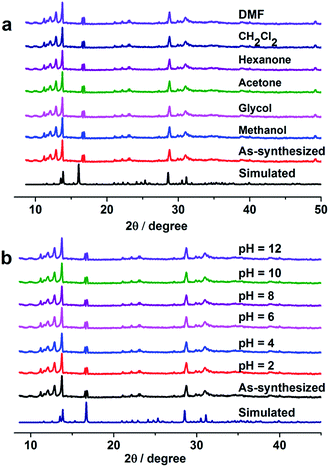 | ||
| Fig. 2 PXRD patterns of 1: (a) the immersion of 1 in different solvents. (b) The immersion of compound 1 in aqueous solutions with different pH values. | ||
UV-vis spectroscopy
The UV-vis diffuse reflectance absorption spectrum of compound 1, K3HMo5O17 and Cu3(trz)3(OH)3(H2O)4 were tested as presented in Fig. 3, S10 and S11, ESI.† The result showed that their Eg were 2.34 eV, 2.87 eV and 1.67 ev, respectively. We take 1 as model to show the relationship of UV-vis diffuse reflectance absorption spectrum and Eg. In the ultraviolet range, the lowest energy band at 265 nm can be assigned to the charge–transfer transition from O → Mo, the higher energy band at 780 nm arises from the d–d electronic transition of the Cu centers.10 The optical band gaps (Eg) of 1 have been calculated using Tauc's relation:11 (αhν) = A(hν − Eg)n; where α, ν, h, n, Eg and A stand for absorption coefficient, frequency, Planks' constant, transition coefficient, band gap and band tailing parameter, respectively. Among them, A is a constant and α is the optical absorption coefficient given by the Kubelka–Munk function: F(R∞) = (1 − R∞)2/2R∞, R∞ = (I/Io)diff is the diffuse reflectivity. The index n is a number which characterizes the transition process involved. The intercept of the linear plots (αhν)n with the E-axis gives a direct transition (n = 1/2) at 2.34 eV (Fig. 3). The results demonstrate the semiconductor nature for 1.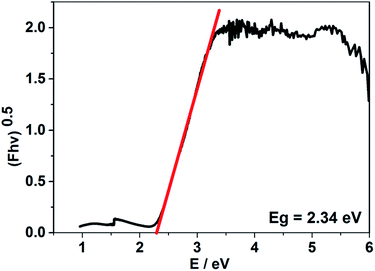 | ||
Fig. 3 The diffuse reflectance UV-vis-NIR spectrum of (Fhν)0.5 vs. energy (eV) for 1. F = (1 − R) × (1 − R)/2R; A = log![[thin space (1/6-em)]](https://www.rsc.org/images/entities/char_2009.gif) 1/R. 1/R. | ||
Magnetic property
The temperature dependence of magnetic susceptibility of 1 was investigated at 2–300 K in an applied magnetic field of 1000 Oe. The χM versus T plot demonstrated the χM value slowly increases from 0.0071 emu mol−1 at 300 K to 0.045 emu mol−1 at 26 K, and then exponentially reaches the maximum value of 0.47 emu mol−1 at 2 K. The χMT value of 1 is 2.13 emu K mol−1 at 300 K (Fig. 4), which is larger than the theoretical value of 1.125 emu K mol−1 expected from three isolated Cu2+ (S = 0.5, g = 2.0). As the temperature is lowered, the χMT value decreases slowly up to 50 K and then sharply falls to a minimum value of 0.94 emu K mol−1 at 2 K. The temperature dependences of χM and χMT versus T plots for 1 suggest the presence of antiferromagnetic coupling interactions between Cu2+ centers. The χM−1 versus T plot follows the Curie–Weiss law with C = 3.56 emu K mol−1 and θ = −29.97 K in the range of 48–300 K (Fig. S12, ESI†), which further demonstrated the presence of antiferromagnetic interactions between Cu2+ ions in 1. The result was correspondent with the previously report6 about TTC compound, antiferromagnetic interactions existing in the TTC core.Catalysis for condensation reaction of cyclohexanone and glycol
In many organic reactions, carbonyl protection reaction is one of the most important intermediate processes. Cyclohexanone reacts with glycol to form cyclohexanone ethylene ketal is a typical carbonyl protection reaction, in which acid catalyst plays a significant role.12 Herein, we chose the synthesis of cyclohexanone ethylene ketal as a model reaction to research the acid catalytic activity of 1. With single factor level analysis, we obtained the optimum reaction conditions of yields of ketals: reaction time were 3.0 hours, cyclohexanone/glycol molar ratio is 1![[thin space (1/6-em)]](https://www.rsc.org/images/entities/char_2009.gif) :
:![[thin space (1/6-em)]](https://www.rsc.org/images/entities/char_2009.gif) 1.5, the amount of acid catalyst 1 was 0.1 g, the most suitable volume of water-carrying agent cyclohexane was 16 mL, reaction temperature was allowed to reflux at 100–105 °C (Fig. 5). Under the optimum experimental conditions, the yield of cyclohexanone ketal was 95%. The ketal product was characterized by FT-IR (Fig. S13, ESI†) and PXRD (Fig. S14, ESI†). After 1 h of reaction, the catalyst was removed through hot filtration and the filtrate was further heated for 2 h at 100 °C. No further growth of the conversion (Fig. 5e) indicated that 1 was a heterogeneous catalyst in the catalytic reaction and was not dissolved in the reaction system. 1 was recovered by centrifugation after 3 h of reaction. The catalyst could be reused for at least 5 times, without significant loss of catalytic activity (Fig. 5f). Additionally, as exhibited in Table 1, compound 1 showed better catalytic activity than the parent materials K3Mo5O17H and Cu3(trz)3(OH)3(H2O)4, in the presence of which the yield of cyclohexanone ethylene ketal were 95%, 44% and 36%, respectively (Table 1). The reaction mechanism of the condensation of cyclohexanone and glycol catalyzed by 1 was Lewis acid active sites, which come from unsaturated coordination sites of Cu centers attack on the carbonyl carbon forming C+ ion, and then C+ ion accepts the attack of nucleophile glycol forming ketals (Fig. S15†).
1.5, the amount of acid catalyst 1 was 0.1 g, the most suitable volume of water-carrying agent cyclohexane was 16 mL, reaction temperature was allowed to reflux at 100–105 °C (Fig. 5). Under the optimum experimental conditions, the yield of cyclohexanone ketal was 95%. The ketal product was characterized by FT-IR (Fig. S13, ESI†) and PXRD (Fig. S14, ESI†). After 1 h of reaction, the catalyst was removed through hot filtration and the filtrate was further heated for 2 h at 100 °C. No further growth of the conversion (Fig. 5e) indicated that 1 was a heterogeneous catalyst in the catalytic reaction and was not dissolved in the reaction system. 1 was recovered by centrifugation after 3 h of reaction. The catalyst could be reused for at least 5 times, without significant loss of catalytic activity (Fig. 5f). Additionally, as exhibited in Table 1, compound 1 showed better catalytic activity than the parent materials K3Mo5O17H and Cu3(trz)3(OH)3(H2O)4, in the presence of which the yield of cyclohexanone ethylene ketal were 95%, 44% and 36%, respectively (Table 1). The reaction mechanism of the condensation of cyclohexanone and glycol catalyzed by 1 was Lewis acid active sites, which come from unsaturated coordination sites of Cu centers attack on the carbonyl carbon forming C+ ion, and then C+ ion accepts the attack of nucleophile glycol forming ketals (Fig. S15†).
| Entry | Catalyst | Time/h | Yield/% |
|---|---|---|---|
a Reaction conditions: the molar ratio of cyclohexanone to glycol was 1![[thin space (1/6-em)]](https://www.rsc.org/images/entities/char_2009.gif) : :![[thin space (1/6-em)]](https://www.rsc.org/images/entities/char_2009.gif) 1.5; water-carrying agent: 16 mL of cyclohexane; reaction temperature: 100–105 °C; the molar ratio of the catalyst was 0.06 mmol. 1.5; water-carrying agent: 16 mL of cyclohexane; reaction temperature: 100–105 °C; the molar ratio of the catalyst was 0.06 mmol. |
|||
| 1 | K3HMo5O17 | 3 | 44 |
| 2 | Cu3(trz)3(OH)3(H2O)4 | 3 | 36 |
| 3 | Compound 1 | 3 | 95 |
Photocatalysis property
POMs-based coordination polymer was introduced transition metal and organic ligand as functional groups, which could enrich the potential applications of POMs, such as catalysis and conductivity. Some POMs-based coordination polymers have been proven to be an excellent kind of green and cheap photocatalyst and can be used to photodecomposition of organic dyes.13 Liu et al.13a synthesized a POMs-based coordination polymer [WO4Ni(en)2(H2O)}3][Ni(en)3]{P2W18O62}·[Ni(en)3]CO3·H2O (en = ethanediamine), which achieved 97% degradation rate for the photocatalytic degradation of methylene blue (MB) under visible light irradiation. Luo et al.13b reported a POMs-based coordination polymer {Cu2(L)2[CrMo6(OH)5O19](H2O)2}·2H2O (L = N,N′-bis(3-pyridinecarboxamide)-1,3-propane), which exhibited photocatalytic activity on the photodecomposition of RhB under visible light with 97.6% degradation rate. Herein, we investigated the photodecomposition activity of 1 for RhB. We chose visible light as the light source, because the calculated HOMO–LUMO gap (Eg) of compound 1 was 2.34 eV, which corresponds to visible light absorption. The UV-vis diffuse reflectance spectrum of 1 was presented in Fig. 3 and S11, ESI.†The photodegradation rate of RhB by 1 was 98% in 200 min. After reuse five times, the result did not change evidently (Fig. 6a and c). For a comparative purpose, the photodecomposition rate in the presence of (TBA)3[Mo5O17H], Cu3(trz)3(OH)3(H2O)4 and blank were also measured, respectively. We could find that photodecomposition rates of RhB by (TBA)3[Mo5O17H], Cu3(trz)3(OH)3(H2O)4 and blank were only 37%, 13% and 8% respectively(Fig. 6b), which were much lower than that by 1.
We proposed that the photodegradation of RhB by 1 was realized by the synergy effect of Cu3(trz)3(OH)32+ and Mo5O186− units of 1. The maximum absorbance wavelength of UV-vis diffuse reflectance spectrum of (TBA)3[Mo5O17H] and Cu3(trz)3(OH)3(H2O)4 were 280 nm and 520 nm, respectively (Fig. S9 and b, ESI†). Therefore, Cu3(trz)3(OH)32+ acts as sensitizer absorbing visible light to produce photo-introduced electron. The photo-introduced electron is transferred to the lower LUMO orbit of Mo5O186− and then combined with O2 in air generated O2−˙ radical, which acts as oxidizing agent to effectively attack and oxidize RhB molecule. The proposed mechanism was showed in Fig. 7.
Conclusions
In summary, a new 3D coordination polymer built by triangle trinuclear copper units and triazole with [Mo5O18]6− anions as templates were successfully synthesized. Its catalytic activities in the synthesis of cyclohexanone ethylene ketal and visible light photodegradation of RhB were explored. It exhibits good Lewis acid catalytic activity for the synthesis of cyclohexanone ethylene ketal with 95% conversion after 3 h. Its forbidden bandwidth belongs to the semiconductor category, and it can catalyze the photodecomposition of RhB under visible-light with above 98% degradation rate, demonstrating it is an effective catalyst for the removal of organic pollutant under visible light. This work demonstrates that it is a feasible way to achieve POMs-based coordination polymer with excellent catalytic performance by combining catalytic active building blocks. To some degree, this may offer an access to obtain a series of POMs-based catalysts bearing attractive catalytic activities. This continuous research is currently going on in our group.Conflicts of interest
There are no conflicts to declare.Acknowledgements
This work was supported by the National Natural Science Foundation of China (Grants 91622108, 21371029, 21671033, and 21571030) and the Open Research Fund of the State Key Laboratory of Inorganic Synthesis and Preparative Chemistry (Jilin University, Grant 2015–01).Notes and references
- (a) A. Dolbecq, E. Dumas, C. R. Mayer and P. Mialane, Chem. Rev., 2010, 110, 6009–6048 CrossRef CAS PubMed; (b) H. Ji, X. Li, D. Xu, Y. Zhou, L. Zhang, Z. Zuhra and S. Yang, Inorg. Chem., 2017, 56, 156–166 CrossRef CAS PubMed; (c) J. Thiel, C. Ritchie, H. N. Miras, C. Streb, S. G. Mitchell, T. Boyd, M. N. Corella Ochoa, M. H. Rosnes, J. McIver, D.-L. Long and L. Cronin, Angew. Chem., Int. Ed., 2010, 49, 6984–6988 CrossRef CAS PubMed; (d) Q.-G. Zhai, X.-Y. Wu, S.-M. Chen, Z.-G. Zhao and C.-Z. Lu, Inorg. Chem., 2007, 46, 5046–5058 CrossRef CAS PubMed; (e) Q. Zhai, X. Wu, S. Chen, L. Chen and C. Lu, Inorg. Chim. Acta, 2007, 360, 3484–3492 CrossRef CAS.
- (a) X.-B. Han, Y.-G. Li, Z.-M. Zhang, H.-Q. Tan, Y. Lu and E.-B. Wang, J. Am. Chem. Soc., 2015, 137, 5486–5493 CrossRef CAS PubMed; (b) X.-B. Han, Z.-M. Zhang, T. Zhang, Y.-G. Li, W. Lin, W. You, Z.-M. Su and E.-B. Wang, J. Am. Chem. Soc., 2014, 136, 5359–5366 CrossRef CAS PubMed; (c) I. V. Kozhevnikov, Chem. Rev., 1998, 98, 171–198 CrossRef CAS PubMed; (d) F. Lefebvre, F. X. Liu-Cai and A. Auroux, J. Mater. Chem., 1994, 4, 125–131 RSC.
- (a) C. Duan, M. Wei, D. Guo, C. He and Q. Meng, J. Am. Chem. Soc., 2010, 132, 3321–3330 CrossRef CAS PubMed; (b) H. Fu, C. Qin, Y. Lu, Z.-M. Zhang, Y.-G. Li, Z.-M. Su, W.-L. Li and E.-B. Wang, Angew. Chem., Int. Ed., 2012, 51, 7985–7989 CrossRef CAS PubMed; (c) Q. Han, C. He, M. Zhao, B. Qi, J. Niu and C. Duan, J. Am. Chem. Soc., 2013, 135, 10186–10189 CrossRef CAS PubMed.
- (a) W. Ouellette, H. Liu, C. J. O'Connor and J. Zubieta, Inorg. Chem., 2009, 48, 4655–4657 CrossRef CAS PubMed; (b) T. Afrati, C. Dendrinou-Samara, C. Raptopoulou, A. Terzis, V. Tangoulis, A. Tsipis and D. P. Kessissoglou, Inorg. Chem., 2008, 47, 7545–7555 CrossRef CAS PubMed; (c) C. Di Nicola, Y. Y. Karabach, A. M. Kirillov, M. Monari, L. Pandolfo, C. Pettinari and A. J. L. Pombeiro, Inorg. Chem., 2007, 46, 221–230 CrossRef CAS PubMed; (d) S. Hazra, S. Mukherjee, M. F. C. Guedes da Silva and A. J. L. Pombeiro, RSC Adv., 2014, 4, 48449–48457 RSC.
- (a) B. J. Wallar and J. D. Lipscomb, Chem. Rev., 1996, 96, 2625–2658 CrossRef CAS PubMed; (b) E. M. Zueva, M. M. Petrova, R. Herchel, Z. Travnicek, R. G. Raptis, L. Mathivathanan and J. E. McGrady, Dalton Trans., 2009, 38, 5924–5932 RSC; (c) X. Zhu, J.-W. Zhao, B.-L. Li, Y. Song, Y.-M. Zhang and Y. Zhang, Inorg. Chem., 2010, 49, 1266–1270 CrossRef CAS PubMed.
- (a) S. Su, Y. Zhang, M. Zhu, X. Song, S. Wang, S. Zhao, S. Song, X. Yang and H. Zhang, Chem. Commun., 2012, 48, 11118–11120 RSC; (b) S. Bala, S. Bhattacharya, A. Goswami, A. Adhikary, S. Konar and R. Mondal, Cryst. Growth Des., 2014, 14, 6391–6398 CrossRef CAS.
- W. Ouellette, M. H. Yu, C. J. O'Connor, D. Hagrman and J. Zubieta, Angew. Chem., Int. Ed., 2006, 45, 3497–3500 CrossRef CAS PubMed.
- (a) H.-X. Ma, J. Du, Z.-M. Zhu, T. Lu, F. Su and L.-C. Zhang, Dalton Trans., 2016, 45, 1631–1637 RSC; (b) D.-J. Tao, Z.-M. Li, Z. Cheng, N. Hu and X.-S. Chen, Ind. Eng. Chem. Res., 2012, 51, 16263–16269 CrossRef CAS; (c) J.-P. Wang, H.-X. Ma, L.-C. Zhang, W.-S. You and Z.-M. Zhu, Dalton Trans., 2014, 43, 17172–17176 RSC.
- M. Che, M. Fournier and J. P. Launay, J. Chem. Phys., 1979, 71, 1954–1960 CrossRef CAS.
- (a) M. Filowitz, W. G. Klemperer and W. Shum, J. Am. Chem. Soc., 1978, 100, 2580–2581 CrossRef CAS; (b) X. Kuang, X. Wu, R. Yu, J. P. Donahue, J. Huang and C.-Z. Lu, Nat. Chem., 2010, 2, 461–465 CrossRef CAS PubMed.
- B. Tripathi, P. Bhatt, P. Chandra Kanth, P. Yadav, B. Desai, M. Kumar Pandey and M. Kumar, Sol. Energy Mater. Sol. Cells, 2015, 132, 615–622 CrossRef CAS.
- U. Beckmann and S. Brooker, Coord. Chem. Rev., 2003, 245, 17–29 CrossRef CAS.
- (a) Z.-J. Liu, X.-L. Wang, C. Qin, Z.-M. Zhang, Y.-G. Li, W.-L. Chen and E.-B. Wang, Coord. Chem. Rev., 2016, 313, 94–110 CrossRef CAS; (b) Y.-H. Luo, Z.-L. Lang, X.-X. Lu, W.-W. Ma, Y. Xu and H. Zhang, Inorg. Chem. Commun., 2016, 72, 13–16 CrossRef CAS.
Footnote |
| † Electronic supplementary information (ESI) available: IR spectra, PXRD patterns, TG curves, magnetic properties and additional experimental result figures. CCDC 1571612. For ESI and crystallographic data in CIF or other electronic format see DOI: 10.1039/c7ra12150d |
| This journal is © The Royal Society of Chemistry 2018 |

